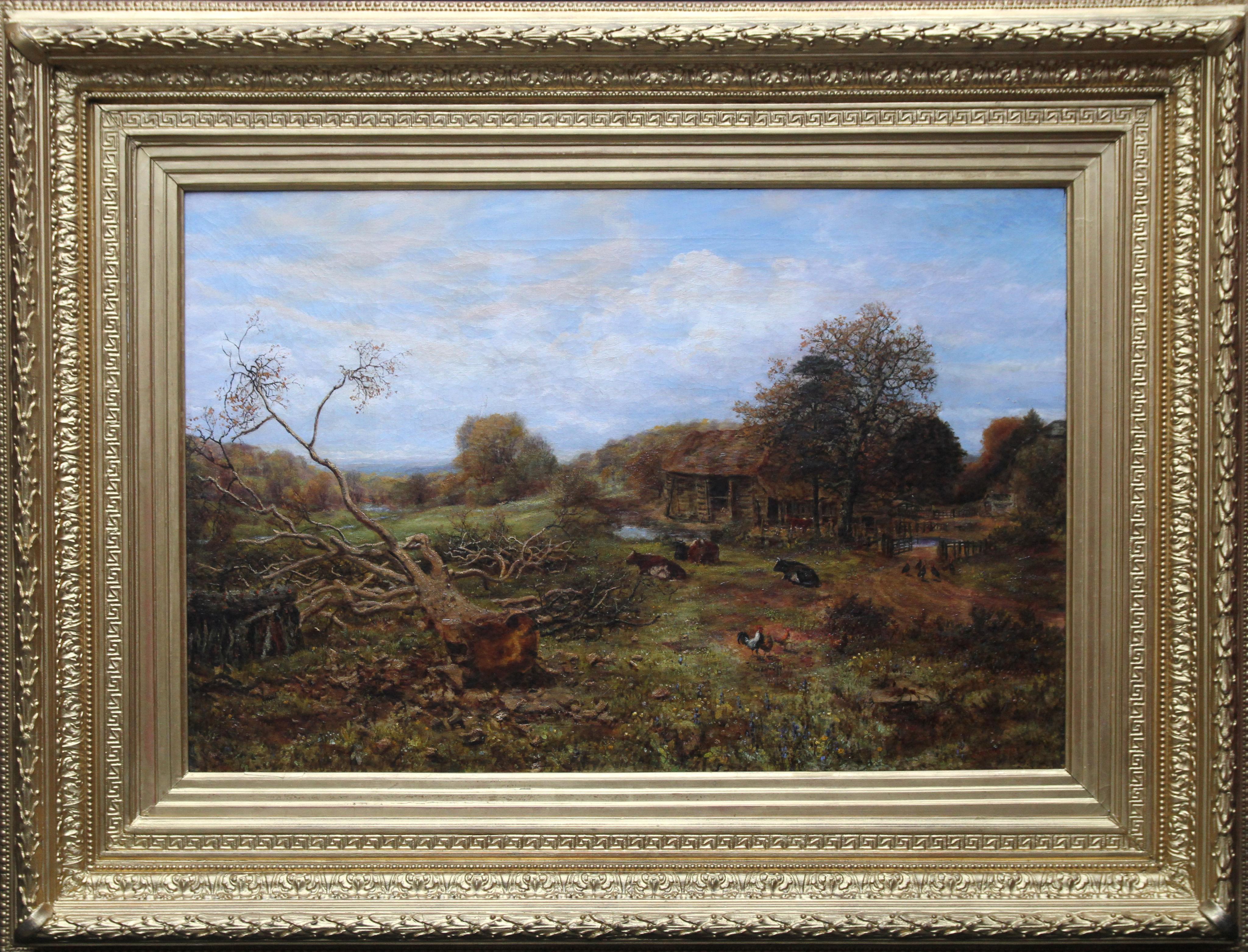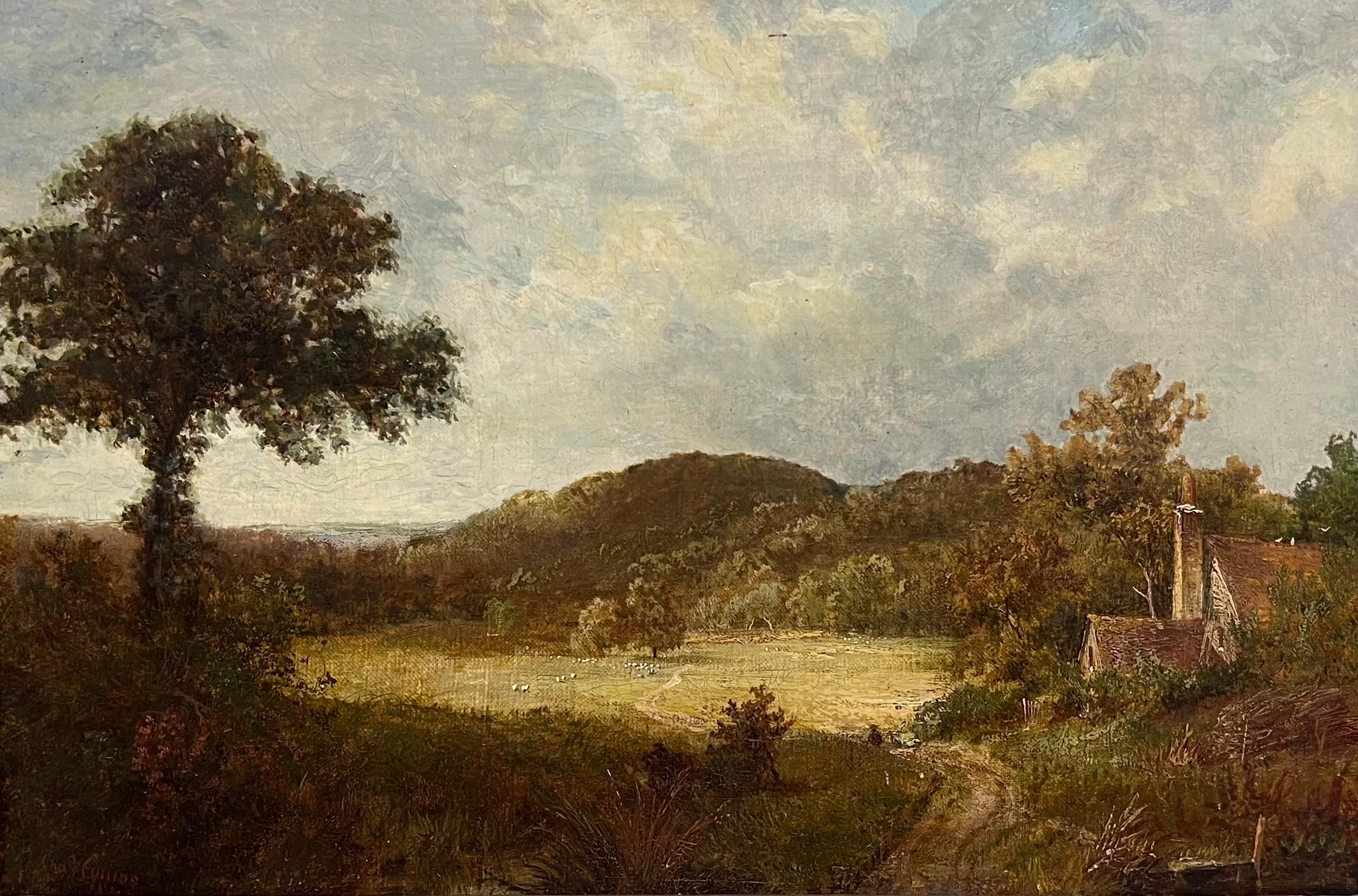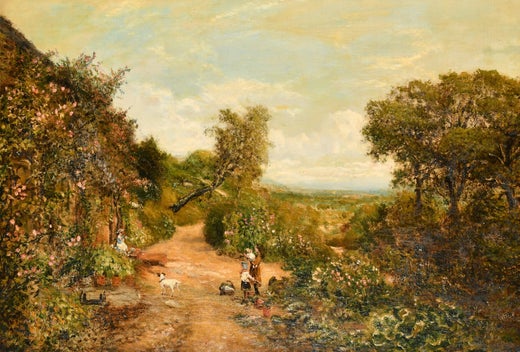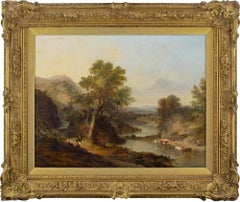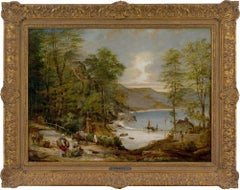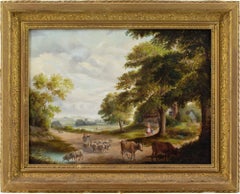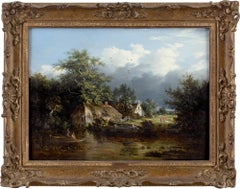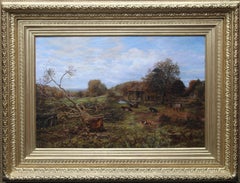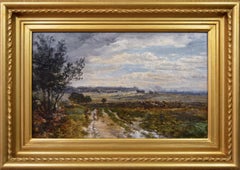Items Similar to George William Mote, Near Guildford, Surrey
Want more images or videos?
Request additional images or videos from the seller
1 of 12
George William MoteGeorge William Mote, Near Guildford, Surrey1888
1888
$2,185.01
£1,600
€1,881.76
CA$2,997.91
A$3,349.67
CHF 1,752.25
MX$41,077.66
NOK 22,390.40
SEK 21,232.03
DKK 14,044.59
Shipping
Retrieving quote...The 1stDibs Promise:
Authenticity Guarantee,
Money-Back Guarantee,
24-Hour Cancellation
About the Item
This late 19th-century oil painting by British painter George William Mote (1832-1909) depicts a shepherd and his flock before an extensive view across the Surrey countryside near Guildford. Curiously, the shepherd is probably the artist himself.
The formative years of Mote’s career remain quite a mystery. His parents divorced when he was a child and he lived with his mother who had worked as a housekeeper in their hometown of Barnet. They were not a particularly wealthy family, however records show that he began exhibiting at the Royal Academy in London in 1857 and was, indeed, living in the capital. He must have therefore found some means through which to begin practising and exhibiting his works. Already at this young age, he was showing considerable talent. A Victorian art critic remarked that he “ought to do well if this be his beginning”.
A move to Worcestershire to receive the patronage of the antiquarian and book collector Sir Thomas Phillips (1792-1872) proved divisive to Mote. He was employed as Phillips’ ‘gardener and caretaker,’ although this might very well have been a phoney position which allowed Mote to paint with Phillips’ patronage. A number of works were listed as being in Phillips’ collection in 1862. Many of these were of the Worcestershire countryside, and indeed, he derived much inspiration from his surroundings. Phillips allowed him and his wife to live in Broadway Tower, a folly with incomparable views of the sweeping Cotswolds.
After receiving Phillips’ patronage, he moved once again to London before finally settling in Surrey. Here the less urbanised, country sprawl offered much for his artistic tendencies to feed off. He continued to exhibit, both at the Royal Academy and at the Suffolk Street Galleries, becoming a recurring feature of each show with his curious landscapes.
In his later life, it seems he became quite an infamous figure in his local area. He was taken to court in the 1880s for threatening someone with foul language. It was recorded that he was a “modern Robinson Crusoe” who, in the summer, “lived in caves, which he had dug out of the sandstone, and in the winter he occupied a studio”.
Given that this piece was painted in the same year as one of his court appearances, 1888, it seems plausible that he’s depicted himself digging into the hillside. He considered the land around this temporary abode to be his own and journalists reported that he would threaten any intruders with an old revolver - often getting into tussles.
It is quite a sorrowful story to read that upon his death in 1909, his body was discovered in a “dirty condition”. The police “stated that they had never seen a man in a more terrible state of personal neglect”. The days of patronage in a glorious folly were long behind him, as were his days as a landscape painter. Nonetheless, his works remain as fascinating examples of a self-taught artist, influenced primarily by the world around him, and the nature he seemingly retreated to in his old age.
Signed in the lower right and held in a period frame, which is probably original.
Provenance: British, Continental & Russian Pictures (Sale No.5103), Christie’s, London, January 10, 2007, lot 868 / Private collection, UK.
Artist’s auction maximum: £27,025 for ‘Woman and Child Crossing a Bridge by a Lake’, Oil on canvas, Christie’s, Victorian Pictures, London, 2000 (lot 72).
- Creator:George William Mote (1832 - 1909, British)
- Creation Year:1888
- Dimensions:Height: 41 in (104.14 cm)Width: 35 in (88.9 cm)
- Medium:
- Movement & Style:
- Period:
- Condition:Frame with various marks and showing its age. Otherwise very presentable.
- Gallery Location:Cheltenham, GB
- Reference Number:1stDibs: LU2328215021262
George William Mote
George William Mote was a self-taught artist, who worked as gardener and caretaker to Sir Thomas Phillipps, the great manuscript collector at Middle Hill, near Broadway Worcester. His early paintings, mostly of the house and gardens at Middle Hill, are painted in an evocative primitive style, which faithfully reproduces the scene. Later, he became a full-time artist and enjoyed success in exhibiting at the Royal Academy 1857–73, the British Institution and in the Provinces.
About the Seller
5.0
Platinum Seller
Premium sellers with a 4.7+ rating and 24-hour response times
Established in 2017
1stDibs seller since 2023
238 sales on 1stDibs
Typical response time: 1 hour
- ShippingRetrieving quote...Shipping from: Cheltenham, United Kingdom
- Return Policy
Authenticity Guarantee
In the unlikely event there’s an issue with an item’s authenticity, contact us within 1 year for a full refund. DetailsMoney-Back Guarantee
If your item is not as described, is damaged in transit, or does not arrive, contact us within 7 days for a full refund. Details24-Hour Cancellation
You have a 24-hour grace period in which to reconsider your purchase, with no questions asked.Vetted Professional Sellers
Our world-class sellers must adhere to strict standards for service and quality, maintaining the integrity of our listings.Price-Match Guarantee
If you find that a seller listed the same item for a lower price elsewhere, we’ll match it.Trusted Global Delivery
Our best-in-class carrier network provides specialized shipping options worldwide, including custom delivery.More From This Seller
View AllWilliam Traies (Attributed), Wooded River Landscape With Cascade & Figures
Located in Cheltenham, GB
This charming mid-19th-century oil painting attributed to English artist William Traies (1789-1872) depicts a picturesque river view with cascade, figures and cattle. Traies was an a...
Category
1840s Victorian Landscape Paintings
Materials
Oil, Canvas
Edward William Cooke RA, West-Country Cove With Cottages, Family & Donkeys
By Edward William Cooke
Located in Cheltenham, GB
This idyllic late 19th-century oil painting by English artist Edward William Cooke RA (1811-1880) depicts a west-country cove with two cottages, donkeys, figures, and fishing boats. Cooke was a highly renowned painter of marine scenes and landscapes who exhibited extensively at London’s Royal Academy.
From our elevated vantage point, the view extends between two quaint cottages and across the beach before sweeping around the sandy coastline. Crystalline waters lap the shore, where moored craft rest. It’s an accomplished rendering of a challenging composition. It’s enhanced by trees, which essentially ‘frame’ the right side, while a wooded track provides interest on the left.
Cooke was a keen admirer of the Dutch old masters, and the spirit of the Golden Age underpins this splendid work. In diaries, he recorded how he travelled by donkey to access elevated spots in the southwest, so it’s conceivable that he did so here. In his catalogue raisonné, it lists a work from the same year titled ‘Bay with Donkeys’.
Born in Pentonville, London, Cooke was raised in the company of accomplished artists as both his father, George Cooke (1781-1834), and his uncle, William Bernard Cooke (1778-1855), were engravers. As such, they were associated with a circle of Victorian painters who aided Cooke’s early development. These included the highly regarded marine painter Clarkson Frederick Stanfield RA RBA (1793-1867), who provided frequent advice and inspiration. Indeed, as a teenager, Cooke produced numerous drawings after Stanfield’s works.
A precocious talent, by the age of nine, he was already displaying an advanced understanding of engraving, particularly for ships, coupled with a natural, seemingly in-built skill as a draughtsman. Many of his early drawings depict pastoral landscapes after the masters, such as Nicolaes Berchem (1620-1683), Paulus Potter (1625-1654), and Karel Dujardin (1626-1678).
In an extraordinary turn of events, in 1820, his advanced abilities led to his first commission when he provided botanical illustrations for John Loudon's 'Encyclopaedia of Plants’. These were followed by drawings published in the 'Botanical Cabinet...
Category
1870s Victorian Landscape Paintings
Materials
Canvas, Oil
Mid-19th-Century English School, Rural Scene With Family, Cattle & Cottage
Located in Cheltenham, GB
This endlessly charming mid-19th-century English oil painting depicts a rural scene with a family, cattle, pond, and cottage.
A mother and child pause to observe a drover, perhaps f...
Category
1830s Landscape Paintings
Materials
Canvas, Oil
Edward Charles Williams (Attributed), Wooded River Landscape With Boathouse
By Edward Charles Williams
Located in Cheltenham, GB
This mid-19th-century oil painting, attributed to English artist Edward Charles Williams (1807-1881), depicts a wooded river landscape with a boathouse, cottage, fishermen and figure...
Category
1850s Victorian Landscape Paintings
Materials
Panel, Oil
Robert Russell MacNee, Landscape With Farm, Track & Horses
By Robert Russell Macnee
Located in Cheltenham, GB
This evocative early 20th-century oil painting by Scottish artist Robert Russell MacNee RGI (1880-1952) depicts a farm with a track, horses, and figures. MacNee was an accomplished p...
Category
1910s Landscape Paintings
Materials
Oil, Board
Mid-19th-Century Belgian School, Windswept Landscape With Cottage
Located in Cheltenham, GB
This mid-19th-century Belgian oil painting depicts a windswept landscape with a cottage, figures, copse and grazing cattle.
A brisk gale rushes across the scenery, clutching at ever...
Category
1860s Landscape Paintings
Materials
Oil, Canvas
You May Also Like
Landscape - Oil on Canvas by G. W. Mote - 1888
By George William Mote
Located in Roma, IT
Landscape is an original oil painting on canvas, realized by the British artist George William Mote (1832-1909).
Hand-signed and dated in red oil color on lower right corner "G.W. M...
Category
1880s Landscape Paintings
Materials
Canvas, Oil
Landscape with Cattle - Surrey - British Victorian art 19th century oil painting
By George William Mote
Located in London, GB
This charming Victorian landscape oil painting is by noted prolific exhibited British artist George William Mote. Mote was very fond of painting landscapes in Surrey and this is a pa...
Category
1880s Victorian Landscape Paintings
Materials
Oil
Cadzow Forest Scotland - British mid 19thC art Scottish landscape oil painting
By Samuel Bough
Located in London, GB
This lovely British Victorian landscape oil painting is by noted artist Sam Bough. It was painted in 1855 after Bough had moved to Hamilton Lanarkshire in Scotland to focus on painting landscapes alongside fellow artist Alexander Frazer. The location is the ancient forest of Cadzow in Lanarkshire which they both favoured. The landscape is of a rough path through ancient oaks heading towards more dense forest with white cattle grazing to the right. A superb balanced composition and an excellent example of Bough's skill in landscape painting.
Signed lower left and dated 1855.
Provenance. Christie's stencil verso 519GG.
James Bourlet & Sons label verso.
Condition. Oil on canvas, 28 inches by 18 inches unframed and in good condition.
Frame. Housed in an ornate gilt Victorian frame, 35 inches by 25 inches framed and in good condition.
Samuel Bough RSA (1822–1878) was an English-born landscape painter who spent much of his career working in Scotland. He was born the third of five children in Abbey Street, Carlisle in northern England, the son of James Bough (1794-1845), a shoemaker, and Lucy Walker, a cook. He was raised in relative poverty, but with a keen encouragement in the arts. He was self-taught but mixed with local artists such as Richard Harrington and George Sheffield, and was strongly influenced by the work of Turner. After an unsuccessful attempt to live as an artist in Carlisle he obtained a job and as a theatre scenery painter in Manchester in 1845, later also working in Glasgow in the same role. Encouraged by Daniel Macnee to take up landscape painting he moved to Hamilton from 1851-4 and worked there with Alexander Fraser. In 1854 he moved to Port Glasgow to work on his technique of painting ships and harbours. His paintings were noted for their sensitivity to atmosphere and light, were often of cloudy shorelines and busy harbours. He also began supplementing his income by illustrating books, before moving to Edinburgh in 1855. On coming to Edinburgh he lived in a terraced house at 5 Malta Terrace in the Stockbridge area of the city. Following Turner's example, he became a skil ful painter of seaports. He was buried in Dean Cemetery Edinburgh on 23 November 1878. The grave bears a bronze medallion of his head by William Brodie...
Category
Mid-19th Century Realist Landscape Paintings
Materials
Oil
$8,711 Sale Price
20% Off
19th century landscape oil painting of figures at Sutton Park
Located in Nr Broadway, Worcestershire
William E Harris
British, (1854-1930)
*Sutton Park
Oil on canvas, signed & dated 1884, inscribed verso
Image size: 9.5 inches x 15.5 inches
Size incl...
Category
19th Century Victorian Landscape Paintings
Materials
Canvas, Oil
Victorian English Signed Oil Painting 1870's Rural Country Landscape Gilt Framed
By Charles Collins
Located in Cirencester, Gloucestershire
The English Rural Landscape
by Charles Collins (British, circa 1870's)
signed & dated
oil on canvas, framed
framed: 17 x 24 inches
canvas: 12 x 18 inches
Provenance: private collecti...
Category
1870s English School Landscape Paintings
Materials
Canvas, Oil
Sheep in a Surrey Landscape - British Victorian art sunny landscape oil painting
By George William Mote
Located in London, GB
This lovely Surrey landscape oil painting is by noted British exhibited artist George William Mote. Painted circa 1870, the composition is a landscape with a stunning view into the d...
Category
19th Century Realist Landscape Paintings
Materials
Oil
More Ways To Browse
Antique Records
Christie Brown
Police Signs
Antique Robinson
George Read Art
Used Tower Garden
Gallery Flock
Lake George Painting
Hillside Original
The London Police
Winter Landscapes Russian
Lake George Oil Painting
Used Revolvers
Shepherd And Flock
Antique Police
19th Century Robinson
Tower Bridge Antique
Victorian Winter Landscape

